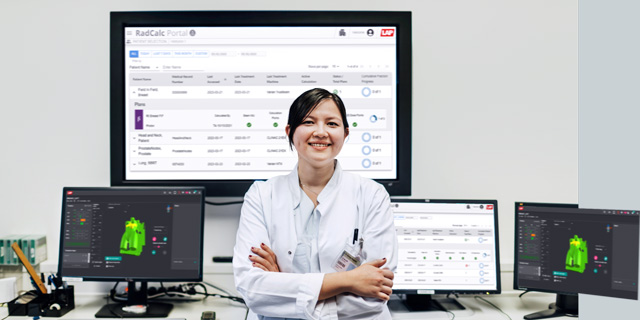site licensing.
MR LINACs
MR LINACs set new standards in radiotherapy. RadCalc supports secondary MU and point dose verification for MR LINACs. The calculations take the presence of the magnetic field into account through the imported measurement profiles. All calculations can be automated together with RadCalc’s import, export and reporting features. Additionally, for Elekta Unity RadCalc provides a plan integrity check with the plan comparison tool.
LINACs
RadCalc performs independent MU or point dose verification calculations for photon and electron treatment plans. The RTP Import, R&V Export and IMRT utilities add value in automation and precision. The IMRT utility verifies MU and point dose calculations for all modulated treatments.
The advancements in RadCalc v7 provide Monte Carlo and Collapsed Cone Convolution Superposition algorithms that deliver fast, easy, and accurate 3D dose volume verification. Additionally, the EPID dosimetry module provides true composite 3D pre-treatment QA and in-vivo dosimetry phantom-less workflows.
Included with every install, RadCalcAIR (Automated Import & Reporting) provides an automated process with tools for percent difference, DVH, Gamma and Distance to Agreement analysis and more. RadCalc alerts you to plans that trigger the customizable action limits for Gamma Analysis criteria, MU/dose level, and DVH metrics for critical structures.
Halcyon and Ethos
RadCalc provides 3D dose volume verification with Collapsed Cone and Monte Carlo as well as point dose verification for Halcyon and Ethos machines, supporting Varian’s dual-layer MLC. For 3D calculation features such as dose volume analysis and gamma calculation, DVH protocols and analysis lines can be utilized. The EPID dosimetry module provides true composite 3D pre-treatment QA and in-vivo dosimetry phantom-less workflows. Furthermore, RadCalc’s automated calculation and reporting features enhance user workflows.
TomoTherapy
RadCalc supports TomoHelical, TomoDirect and TomoEDGE and verifies the treatment time and dose to multiple calculation points. Each control point can be visualized together with the illustrated leaf open times and the sinogram is displayed. The process is automated and can be integrated into workflows, by automatically importing the treatment plan, performing the calculation, evaluating the result, and preparing the report.
Pencil Beam for point dose and 3D Monte Carlo decomposes each control point into a set of finite beamlets with an appropriate weighting such that their summation reproduces the imported sinogram for the control point.
CyberKnife
RadCalc supports CyberKnife machines equipped with fixed Cone, Iris or MLC. The treatment plan can be imported from MultiPlan or from Precision TPS. RadCalc provides point dose calculation options and other features for CyberKnife machines, such as fully automated calculation and reporting.
Gamma Knife
RadCalc performs point dose verification calculations for various Gamma Knife versions and the Leksell GammaPlan (LGP) planning system.
RadCalc stores and maintains a copy of the Elekta proprietary data providing independent table lookup and interpolation processes. External contour determination from skull scalar instrument measurements or thresholded images is independent along with the ray-tracing process for depth determination.
RadCalc computes the dose and percent difference for each target utilizing proprietary TMR data, OAR data, and source position information. RadCalc utilizes a virtual machine to perform the dose computation - no physics setup is necessary. RadCalc’s virtual machine automatically selects the data based upon the type of plan.
Cobalt 60
The Co60 treatment plans can be imported from treatment planning system or from any supported record and verify system. They can contain wedges, blocks and cutouts which can be imported with the plan or defined manually in RadCalc.
Expected doses measured by diode or TLD during a Co60 treatment can be calculated by RadCalc and the results can be stored during all treatment fractions, individually. The measured in-vivo doses complement the patient medical record and can be stored in the record and verify system.
Superficial (Orthovoltage)
RadCalc superficial calculations are based on real measured values. The software allows the definition of multiple energies with individual HVL values and energy specific parameters. Every energy can have a list of allowed SSDs, cones and measured backscatter factors.
Superficial calculations can have multiple prescriptions and beams within the same calculation. Cones may be shaped as a circle, oval, square, or rectangle, and individual cutouts can be defined. Like any other calculation in RadCalc, the superficial and Co60 calculations can be approved, printed or sent to a record and verify system to be part of the patient medical record.
Brachytherapy
RadCalc supports calculations for permanent seed implant, LDR, HDR and Xoft Brachytherapy machines. The calculations are 3D calculations based on the TG-43 protocol.
Radioactive source types can be added manually or imported from a file. RadCalc also allows the export of Brachytherapy sources, which then can be shared amongst other RadCalc users. For every type of radioactive source an inventory list can be created which holds up-to-date information about the sources and activities available at the institution.
Users may define rotations and/or translations of the source positions even for one single fraction. Dose and DVH results from the shifted source position can be calculated and compared with the original plan. RadCalc calculates the Brachytherapy doses in 3D and compares the DVH with the treatment planning system. DVH protocols can be defined and customized for individual calculations. With RadCalcAIR the Brachytherapy calculations can be automated.



